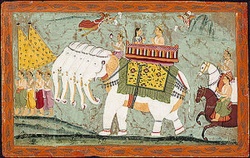Difference between revisions of "Śakra"
| Line 1: | Line 1: | ||
[[File:Indradeva.jpg|thumb|250px|]] | [[File:Indradeva.jpg|thumb|250px|]] | ||
| − | [[Śakra]] ([[Sanskrit]]: [[शक्र]]) or [[Sakka]] ([[Pāli]]) is the [[ruler]] of the [[Trāyastriṃśa]] [[Heaven]] according to [[Buddhist cosmology]]. His full title is [[Śakro devānām indraḥ]] ([[शक्रो देवानं इन्द्रः]]; [[Pāli]]: [[Sakko]] devānaṃ indo "[[Śakra]], [[lord]] of the [[devas]]". In [[Buddhist texts]], [[Śakra]] is the proper [[name]] and not an [[Epithet]] of this [[deity]]; conversely, [[Indra]] in [[Sanskrit]] and [[ | + | [[Śakra]] ([[Sanskrit]]: [[शक्र]]) or [[Sakka]] ([[Pāli]]) is the [[ruler]] of the [[Trāyastriṃśa]] [[Heaven]] according to [[Buddhist cosmology]]. His full title is [[Śakro devānām indraḥ]] ([[शक्रो देवानं इन्द्रः]]; [[Pāli]]: [[Sakko]] devānaṃ indo "[[Śakra]], [[lord]] of the [[devas]]". In [[Buddhist texts]], [[Śakra]] is the proper [[name]] and not an [[Epithet]] of this [[deity]]; conversely, [[Indra]] in [[Sanskrit]] and [[Indra]] in [[Pali]] are sometimes used as an [[Epithet]] for [[Śakra]] as "[[lord]]". |
| − | In {{Wiki|East Asian}} [[traditions]], [[Śakra]] is known as [[Dìshìtiān]] ([[帝釋天]]) or [[Shìtí Huányīn]] ([[釋提桓因]]) in {{Wiki|Chinese}}, and also as [[Taishakuten]] ([[帝釈天]]) in [[Japan]]. In [[China]], [[Śakra]] is sometimes compared to the [[Wikipedia:Taoism|Taoist]] {{Wiki|Jade Emperor}} (Yùhuáng dàdì 玉皇大帝 often simplified in Yùhuáng 玉皇); both share a birthday on the ninth day of the first [[lunar month]] of the {{Wiki|Chinese}} [[Calendar]] (usually in February). | + | In {{Wiki|East Asian}} [[traditions]], [[Śakra]] is known as [[Dìshìtiān]] ([[帝釋天]]) or [[Shìtí Huányīn]] ([[釋提桓因]]) in {{Wiki|Chinese}}, and also as [[Taishakuten]] ([[帝釈天]]) in [[Japan]]. In [[China]], [[Śakra]] is sometimes compared to the [[Wikipedia:Taoism|Taoist]] {{Wiki|Jade Emperor}} ([[Yùhuáng dàdì]] [[玉皇大帝]] often simplified in [[Yùhuáng]] [[玉皇]]); both share a birthday on the ninth day of the first [[lunar month]] of the {{Wiki|Chinese}} [[Calendar]] (usually in February). |
| − | The [[name]] [[Śakra]] "powerful" as an [[Epithet]] of [[Indra]] is found in several verses of the {{Wiki|Rigveda}}. In [[Buddhist texts]], Śakra's [[myth]] and [[character]] are very different from those of the {{Wiki|Vedic}} [[Indra]][dubious – discuss]. According to G.P. Malalasekara, "[[Sakka]] and [[Indra]] are independent conceptions. None of the personal {{Wiki|characteristics}} of [[Sakka]] resemble those of [[Indra]]. Some epithets are [[identical]] but are evidently borrowed, though they are differently explained." | + | The [[name]] [[Śakra]] "[[powerful]]" as an [[Epithet]] of [[Indra]] is found in several verses of the {{Wiki|Rigveda}}. In [[Buddhist texts]], [[Śakra's]] [[myth]] and [[character]] are very different from those of the {{Wiki|Vedic}} [[Indra]][dubious – discuss]. According to G.P. Malalasekara, "[[Sakka]] and [[Indra]] are {{Wiki|independent}} conceptions. None of the personal {{Wiki|characteristics}} of [[Sakka]] resemble those of [[Indra]]. Some {{Wiki|epithets}} are [[identical]] but are evidently borrowed, though they are differently explained." |
| − | The [[Trāyastriṃśa | + | The [[Trāyastriṃśa Heaven]] that [[Śakra]] rules is located on the top of [[Mount Sumeru]] (cf. [[Meru]]), [[imagined]] to be the polar center of the [[physical world]], around which the {{Wiki|Sun}} and [[Moon]] revolve. [[Trāyastriṃśa]] is the [[highest of the heavens]] in direct [[contact]] with [[Earth]]. Like the other [[deities]] of this [[Heaven]], [[Śakra]] is long-lived but {{Wiki|mortal}}. When one [[Śakra]] [[dies]], his place is taken by another [[deity]] who becomes the new [[Śakra]]. [[Buddhist]] stories about [[Śakra]] ({{Wiki|past}} or {{Wiki|present}}) are found in the [[Jātaka]] stories and in several [[suttas]], particularly in the [[Saṃyutta Nikāya]]. |
[[Śakra]] is married to [[Sujā]], daughter of the chief of the [[Asuras]], [[Vemacitrin]] ([[Pāli]] [[Vepacitti]]). Despite this relationship, a state of [[war]] generally [[exists]] between the [[thirty-three gods]] and the [[Asuras]], which [[Śakra]] manages to resolve with minimal {{Wiki|violence}} and no loss of [[Life]]. | [[Śakra]] is married to [[Sujā]], daughter of the chief of the [[Asuras]], [[Vemacitrin]] ([[Pāli]] [[Vepacitti]]). Despite this relationship, a state of [[war]] generally [[exists]] between the [[thirty-three gods]] and the [[Asuras]], which [[Śakra]] manages to resolve with minimal {{Wiki|violence}} and no loss of [[Life]]. | ||
Revision as of 00:27, 29 January 2014
Śakra (Sanskrit: शक्र) or Sakka (Pāli) is the ruler of the Trāyastriṃśa Heaven according to Buddhist cosmology. His full title is Śakro devānām indraḥ (शक्रो देवानं इन्द्रः; Pāli: Sakko devānaṃ indo "Śakra, lord of the devas". In Buddhist texts, Śakra is the proper name and not an Epithet of this deity; conversely, Indra in Sanskrit and Indra in Pali are sometimes used as an Epithet for Śakra as "lord". In East Asian traditions, Śakra is known as Dìshìtiān (帝釋天) or Shìtí Huányīn (釋提桓因) in Chinese, and also as Taishakuten (帝釈天) in Japan. In China, Śakra is sometimes compared to the Taoist Jade Emperor (Yùhuáng dàdì 玉皇大帝 often simplified in Yùhuáng 玉皇); both share a birthday on the ninth day of the first lunar month of the Chinese Calendar (usually in February).
The name Śakra "powerful" as an Epithet of Indra is found in several verses of the Rigveda. In Buddhist texts, Śakra's myth and character are very different from those of the Vedic Indra[dubious – discuss]. According to G.P. Malalasekara, "Sakka and Indra are independent conceptions. None of the personal characteristics of Sakka resemble those of Indra. Some epithets are identical but are evidently borrowed, though they are differently explained."
The Trāyastriṃśa Heaven that Śakra rules is located on the top of Mount Sumeru (cf. Meru), imagined to be the polar center of the physical world, around which the Sun and Moon revolve. Trāyastriṃśa is the highest of the heavens in direct contact with Earth. Like the other deities of this Heaven, Śakra is long-lived but mortal. When one Śakra dies, his place is taken by another deity who becomes the new Śakra. Buddhist stories about Śakra (past or present) are found in the Jātaka stories and in several suttas, particularly in the Saṃyutta Nikāya.
Śakra is married to Sujā, daughter of the chief of the Asuras, Vemacitrin (Pāli Vepacitti). Despite this relationship, a state of war generally exists between the thirty-three gods and the Asuras, which Śakra manages to resolve with minimal violence and no loss of Life.
Śakra is mentioned in many Buddhist sūtras, and is often shown consulting The Buddha on questions of morality. Together with Brahmā, he is considered a protector of the Buddhist religion.
